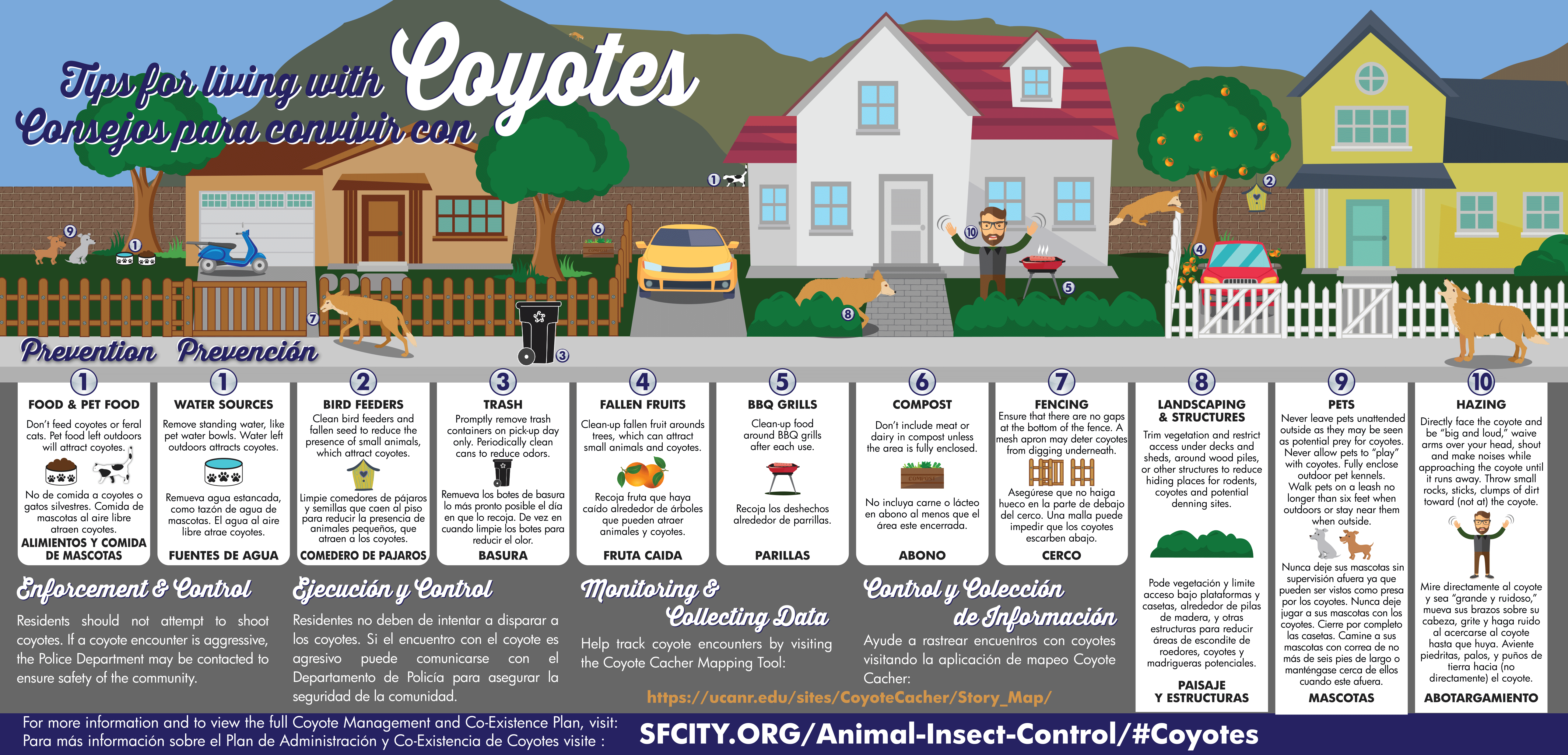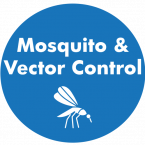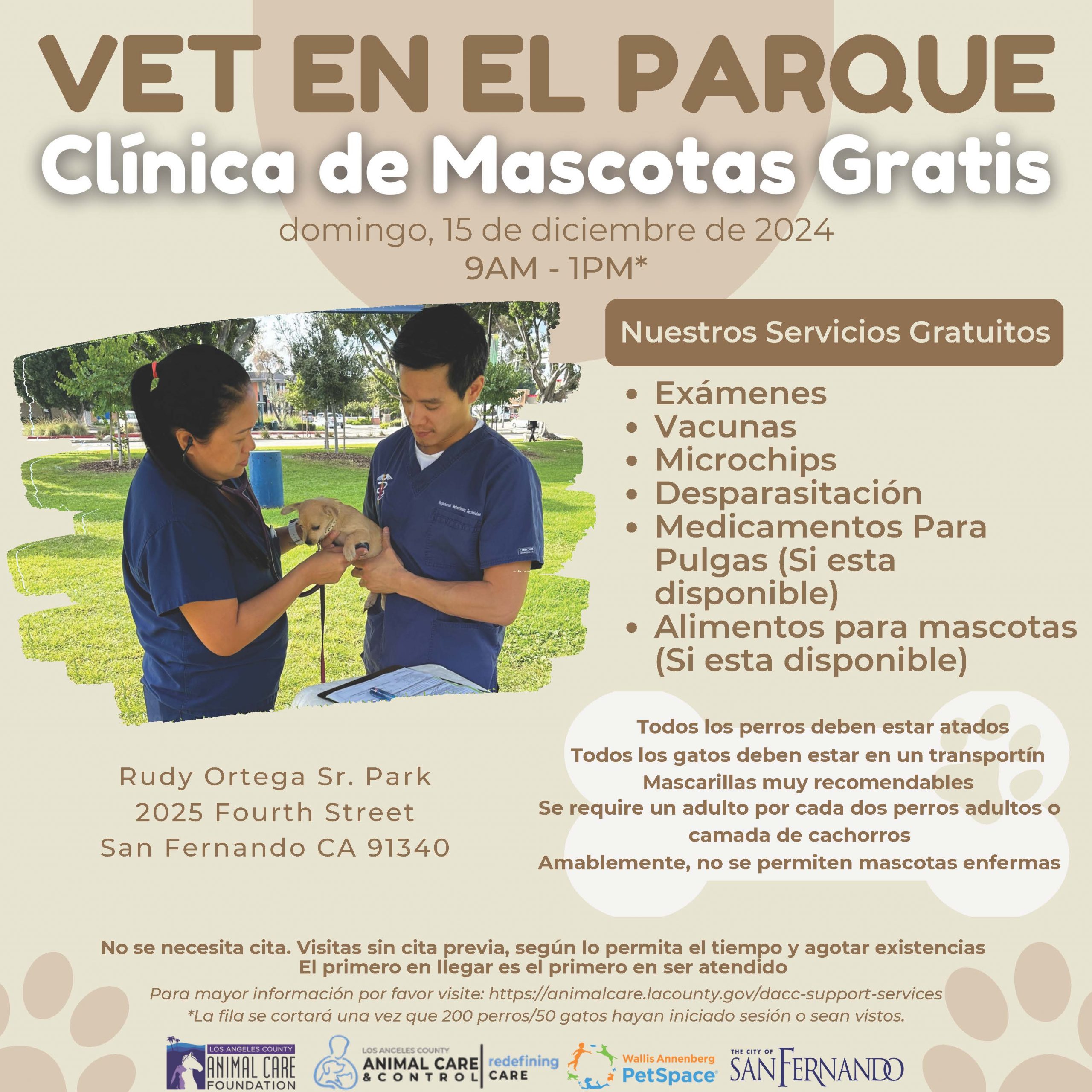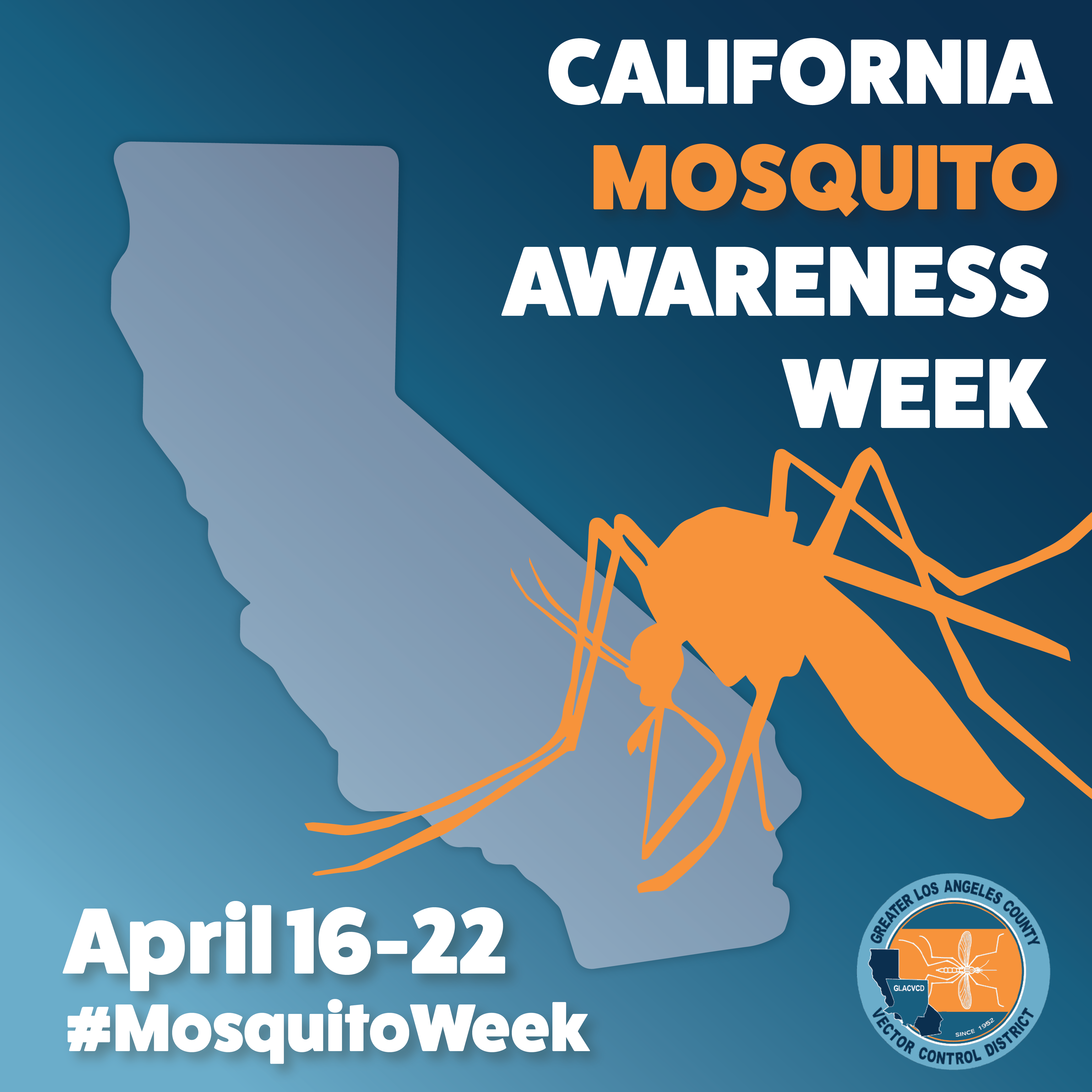COYOTE AWARENESS
As new development encroaches into wildlife habitat and prolonged severe drought conditions become more prevalent, interactions with displaced wildlife, including coyotes, looking for food and water will become more frequent. To provide residents with educational resources and preventative practices to minimize interactions, the City has prepared a Coyote Management and Co-Existence Plan to serve as the basis for community education and outreach.
The Coyote Management and Co-Existence Plan (Coyote Plan) is based on scientific research, a thorough understanding of coyote ecology and biology in suburban settings, and the best known management practices and management tools. This plan is guided by the following basic principles:
- Human safety is a priority in managing human-coyote interactions.
- Coyotes serve an important role in ecosystems by helping to control the population of rodents, rabbits, and other suburban mammals.
- Preventive practices such as reduction and removal of food attractants and responding appropriately when interacting with wildlife are key to minimizing potential interactions with coyotes.
- The Coyote Plan focuses on educating residents in effectively preventing and solving conflicts among coyotes, people, and companion animals.
This Coyote Plan references several existing plans that sourced scientific and peer-reviewed articles from experts in the field of human-coyote conflict resolution, and from successful coyote management plans in neighboring foothill communities. This plan was also written in consultation with key staff throughout the City, including staff from the Public Works, Police, and Administration Departments; all of whom have responded to resident concerns.
Coyotes are native to California and serve an important role in our ecosystem by helping control the population of rodents, rabbits, and other suburban mammals. Human safety is also a priority in managing human-coyote interactions.
The City of San Fernando’s goal is to involve the community in coyote management efforts by increasing behavior and providing tools to use when encountering a coyote.

Coyotes can be attracted into neighborhoods by human-associated food. Intentional and unintentional feeding can lead coyotes to associate humans with sources of food, which can result in negative interactions among coyotes, people and pets. To reduce food attractants in San Fernando:
- Never hand-feed or otherwise deliberately feed a coyote. It is unlawful to feed coyotes in San Fernando.
- Avoid feeding pets outside. Remove sources of pet food an water. If feeding pets outside is necessary, remove the bowl and any leftover food promptly.
- Do not feed feral cats. While residents who feed feral cats are often concerned that coyotes might prey on the cats, the act of feeding feral cats may cause more harm than good, as coyotes often frequent these locations. Residents should not feed feral cats to avoid attracting coyotes.
Cities may provide a year-round supply of water in the form of storm water impoundments and channels (the Pacoima Wash), irrigation, pet water dishes, etc., which support both coyotes and their prey. In dry conditions, water can be as alluring as food, so residents should remove outdoor water bowls/cans, and secure fountains, pools, and jacuzzis.
Maintain good housekeeping, such as regularly cleaning bird feeders and fallen seed to reduce the presence of small animals and raking areas around bird feeders to help discourage coyote activity near residences.
Keep trash in containers. Promptly remove trash containers on pick-up day only. Bag especially attractive food wastes such as meat scraps or leftover pet food. Periodically clean cans to reduce odors.
Clean-up and remove fallen fruit around trees, which can attract small animals and coyotes.
Clean-up food around BBQ grills after each use.
Don’t include meat or dairy in compost unless the area is fully enclosed.
Fences can be sued to keep coyotes out of residential yards. Ensure that there are no gaps at the bottom of the fence. A mesh apron may deter coyotes from digging underneath.
Parks, greenbelts, open spaces, golf courses, buildings, sheds, decks and crawl spaces, etc., increase the amount of variability of cover for coyotes. They allow coyotes to safely and easily remain close to people, pets, homes, and businesses without detection. In the spring, when coyotes give birth and begin to raise young, they concentrate their activities around dens or burrows in which their young are sheltered. Coyotes may take advantage of available spaces under sheds or decks for use as a den, bringing them into close contact with people and pets.
Trim vegetation and restrict access under decks and sheds, around wood piles, or other structures to reduce hiding places for rodents, coyotes and potential denning sites.
Pets are common in San Fernando. Within their territory, coyotes may consider pets as potential prey or potential competitors. The following techniquest are recommended for pet owners:
- Free-roaming pets, especially cats and sometimes small dogs, may attract coyotes into neighborhoods. The best way to minimize risk to pets is to not leave them outside unattended.
- Coyotes primarily eat small mammals such as mice and rats, but will also prey on slightly larger mammals such as rabbits and groundhogs. Approximately the same size as a groundhog or rabbit, free-roaming outdoor cats may also be seen as eligible prey items by coyotes. It is important to note that attacks on cats are normal coyote behavior and do not indicate a danger for people. The only way to protect cats from coyotes (and the other dangers of outdoor life such as cars, disease, dogs and other wildlife) is to keep cats indoors (or only let them outside in a secure enclosure or when accompanied by a person and under the control of a leash and harness).
- Dogs are also vulnerable to coyote confrontations. These incidents generally involve coyotes who are accustomed or habituated to people (usually due to wildlife feeding), or coyotes who are protecting their territory and pups (usually during breeding season – January through March). Small unattended dogs may be seen as potential prey for coyotes. It is important to either keep dogs on a leash six-feet long or shorter when outdoors or to stay within six feel of them when outside. Attacks on unattended, small dogs are normal coyote behavior and do not indicate a danger for people. Although attacks on larger dogs are rarer, coyotes will sometimes go after a large dog when they feel that their territory is threatened.
- Other domestic animals kept outside, such as chickens and rabbits, may also be viewed as prey by coyotes.
Generally, coyotes are reclusive animals who avoid human contact. When coyotes lose their fear of humans, they may visit public areas even when people are present an may cause conflicts with people and pets. Humans have contributed to this habituation of coyotes by not reacting when they see a coyote. We have a tendency to either ignore them due to fear or to be enamored by them because they are wild animals. To coexist safely, it is important to modify this behavior and attitude in resident coyote populations.
Hazing is an activity or series of activities that is conducted in an attempt to change behaviors of habituated coyotes and/or to re-instill a healthy fear of people in the local coyote population. Hazing techniques include generating loud noises, spraying water, shining bright lights, throwing objects, shouting, etc. Hazing can help maintain a coyote’s fear of humans and deter them from neighborhood spaces such as backyards, greenbelts, and play spaces.
A hazing program encourages the use of harassing actions without employing weapons or causing bodily harm to the coyote. The more often an individual animal is hazed, the more effective hazing is in changing coyote behavior. Being highly intelligent animals, coyotes who are hazed quickly learn to avoid neighborhoods, people, and pets.
The goals of hazing are to:
- Reverse the habituation of coyotes to people, teaching them to once again fear and avoid humans.
- Discourage coyotes from entering public areas such as parks, playgrounds, and yards when people are present.
- Discourage coyotes from approaching people and pets.
- Empower residents by giving them tools to use when they encounter a coyote, thereby reducing their fear of coyotes.
- Increase awareness about coyote behavior among residents and involve the community in coyote management efforts.
BASIC HAZING TECHNIQUES
- Stand tall, make yourself big, wave your arms and shout (don’t scream) while approaching the coyote until he/she runs away.
- Use a noisemaker, such as: your voice, an air horn, pots and pans banged together, a whistle, a shake can (such as a soda can filled with coins or pebbles), jingling keys, or an umbrella popping open and closed.
- Use a projectile (toward, not AT the coyote), such as: sticks, clumps of dirt, small rocks, a tennis ball.
- During warm months, use liquids, such as: a garden hose, a water gun, water balloons.
NOTE: If a coyote has never been hazed before, he/she may not run away immediately just by you vocalizing. You may need to approach the coyote while incorporating some of the above-mentioned deterrents. If the coyote runs a short distance, stops, and turns to look at you, continue to haze the coyote until he/she has completely left the area.
A critical element of a successful coyote management plan is the education and awareness for residents. Education is the key to having residents make appropriate decisions regarding their safety and managing their property and pets. This involves all of the above tips for living with coyotes.
For residents’ convenience, the City has prepared a Yard Audit Checklist that may be downloaded and printed: CLICK HERE TO DOWNLOAD
No access to a printer? Call or email the Administration Department and one will be mailed to you:
(818) 898-1202 | Info@sfcity.org
Monitoring an data collection can help the City document where coyotes are frequently seen, count how many coyotes are within an area, and identify human-coyote conflict hot spots. Gathering specific data on incidents will allow for targeting of educational campaigns and conflict mitigation efforts, as well as the ability to measure success in reducing conflicts over time.
Help track coyote encounters by visiting the Coyote Cacher Mapping Tool to report encounters with coyotes:
Residents should not attempt to shoot coyotes. When one or more coyotes are observed in San Fernando and reported to the City, the San Fernando Police Department may be contacted to ensure safety of the community. The San Fernando Police Department does not have the training or expertise to trap or relocate coyotes. If a coyote is deemed to be in (incapacitated), the Police Department may contact the California Department of Fish and Wildlife for support.
ANIMAL CARE AND CONTROL
Animal Control Officers strive to:
- Protect communities from dangerous animals.
- Rescue sick, injured, or stray animals.
- Investigate animal cruelty, abuse, neglect, and illegal animal fighting.
- Conduct animal licensing inspections.
- Assist local law enforcement and City agencies with animal related issues.
- Remove deceased animals from public areas.
- Enforce local and state ordinances.
Additionally, DACC offers programs and services to residents, such as pet licensing, low-cost vaccinations, microchipping, spay and neutering, pet adoptions, and disaster response. Licensing is an important means of identification and can help to return lost pets to their owners quickly.
For more information, please visit their website or contact the Castaic Animal Shelter which serves San Fernando residents at (661) 257-3191.
MOSQUITO AND VECTOR CONTROL
Mosquitoes are the most dangerous creature in the world. They kill over one million people worldwide each year because they can transmit debilitating, or sometimes deadly viruses like Malaria, West Nile virus, and dengue with just a bite. All Los Angeles County residents play an essential role in protecting their community. Mosquito control is a shared responsibility; residents can take simple steps to reduce them in their neighborhood. Here’s how to reduce the risk of mosquito-transmitted diseases and prevent mosquito breeding in and around your home.
Do-It-Yourself Solutions
Mosquitoes can lay eggs in the smallest places – even a bottle cap! Limiting the number of potential sources is the best method to reduce breeding on your property. Inspect around and inside your home for anything that can hold water such as vases, buckets, plant saucers, old tires, a fountain, an unmaintained swimming pool, yard drains, and even in the leaves of plants. Eliminate any stagnant water and remove the source. If the source cannot be removed, check weekly for standing water to prevent mosquito breeding. Remember to look for mosquito sources every week and after rain events. Download the DIY checklist by visiting bit.ly/diy-mosquito-solutions.
Harvest Water, Not Mosquitoes
If residents need to store water in rain barrels, buckets, or other similar containers for longer than a week, these steps should be taken to ensure they are mosquito-proof:
- Cover all water-filled containers with tightly fitted lids.
- Screen all openings (overflows, gaps in the lid), including roof and floor gutters, with a 1/16-inch fine mesh to keep mosquitoes out.
- Use collected water right away and empty rain barrels completely between rain events.
- Use mosquito bits if you must keep stagnant water for over five days.
- Learn more by going to bit.ly/Rain-Barrel-Upkeep.
Repel, Don’t Swell
Remember to wear insect repellent to protect your health. The CDC recommends using repellents with active ingredients such as DEET, Picaridin, IR3535, or Oil of Lemon Eucalyptus. It is imperative to wear insect repellent when traveling abroad, especially when visiting subtropical and tropical regions. Visit bit.ly/repellent-information for more information.
Join Mosquito Watch
Mosquito Watch is a neighborhood program designed to protect your community from mosquitoes and mosquito-borne diseases. With guidance from mosquito experts and your leadership, you can help mobilize your neighbors to act, and reduce mosquito breeding and disease transmission in your neighborhood. Visit bit.ly/Mosquito-Watch for additional information.
Residents can also contact the Greater Los Angeles County Vector Control District at www.glamosquito.org for additional mosquito-related questions and resources. Follow @GLAmosquito on Facebook, Instagram, and Twitter.
A “vector” is defined in the California Health and Safety code Section 2002 as “any animal capable of transmitting the causative agent of human disease or capable of producing human discomfort or injury including, but not limited to mosquitoes, flies, mites, ticks, other arthropods, and rodents and other vertebrates.”
The Greater Los Angeles County Vector Control District (GLACVCD) follows a comprehensive integrated vector management strategy that includes:
- Surveillance – Vector populations are surveyed with a variety of sampling tools and laboratory techniques to determine whether vector-borne diseases are prevalent. The abundance of vectors like mosquitoes indicates the level of public health risk. Mosquitoes are tested routinely for evidence that West Nile virus (WNV), St Louis encephalitis (SLE), western equine encephalomyelitis (WEE) viruses are circulating. The risk for emerging diseases caused by chikungunya, dengue, and Zika viruses is also evaluated.
- Prevention and Control – Areas where vectors may rest, develop, or reproduce are identified and treated. The broad control strategies are:
- Source Reduction –standing water or other harborage that may support mosquitoes and other vectors is reduced or eliminated.
- Environmental Control –the environment is altered to make it less conducive to develop or harbor mosquitoes and other vectors.
- Biological and Chemical Control – natural predators such as mosquito fish, or biorational pesticides are used to eliminate or manage vector populations.
- Public Education and Outreach – information for residents and local agencies is provided at no additional cost through print literature, press releases, community events, classroom programs, social media posts, and local events.SERVICES
- Submit a Service Request – The GLACVCD provides property inspections on a case-by-case basis to help identify the source of mosquito problems.
- Request Presentations and Events – Book GLACVCD for your next community event or meeting. They provide interactive informational booths and engaging presentations.
- Book GLACVCD Education Program –Through Stimulating, hands-on curriculum, 5th grade students will dive into the amazing world of the most deadly animal on the planet.
- Mosquito Watch –Mosquito Watch is a neighborhood watch program designed to protect our communities from mosquitoes and mosquito-borne diseases.
- Stay Informed – Receive monthly updates and get the latest news as it happens. Subscribe to the GLACVCD E-Alerts by using their sign-up form.
For more information, please visit the GLACVCD website.











